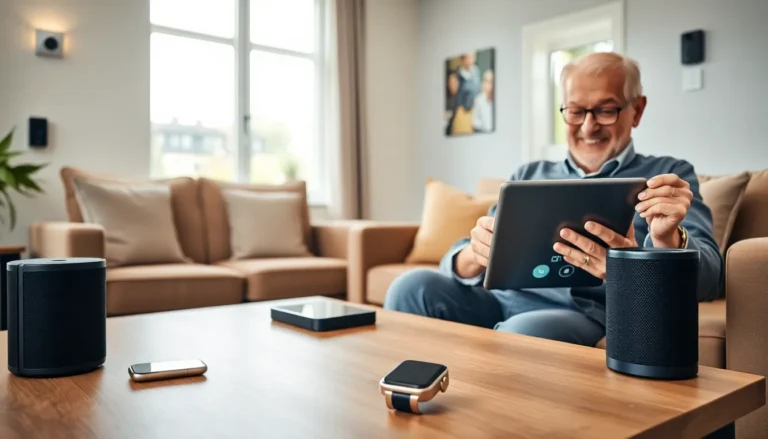Imagine your fridge texting you when you’re out of milk, or your thermostat adjusting itself based on your mood. Welcome to the Internet of Things (IoT), where software development is at the heart of turning dreams into reality. The landscape is ripe with opportunities for innovation, and understanding IoT software development is essential for anyone looking to thrive in this tech-driven world. So, buckle up for a journey into the intricacies of IoT and what it takes to build connected devices that seamlessly improve lives.
Table of Contents
ToggleUnderstanding The Internet Of Things

The Internet of Things is more than just a buzzword: it’s a transformative phenomenon reshaping how devices interact and communicate. By connecting various devices to the internet, IoT allows them to share data, making our lives easier, smarter, and more efficient. From smart homes that control lighting and security systems to industrial applications that monitor equipment performance, the potential is vast. With a myriad of devices being interlinked, the importance of solid software development practices cannot be overstated.
These smart innovations hinge on robust architecture that ensures devices can easily connect and communicate. Understanding this foundational aspect of IoT is crucial for software developers aiming to create compelling solutions.
Key Components Of IoT Systems
Building an effective IoT system requires a harmony between several key components. These include:
- Devices: These can be anything from sensors collecting data to embedded systems in machines. Each device plays a unique role in the overall architecture.
- Connectivity: Devices must communicate effectively. This connectivity can come from various network technologies such as Wi-Fi, Bluetooth, or cellular networks.
- Data Processing: Raw data must be processed using edge computing or cloud computing. This processing is vital for deriving actionable insights.
- User Interface: Finally, to interact with the collected data, a user interface, whether through a mobile app or web dashboard, is essential.
These components are the backbone of any IoT system, and understanding their roles enhances the software development process.
The IoT Development Process
The IoT development process is intricate yet fascinating, involving several critical stages that demand attention to detail and robust planning.
Choosing The Right Technology Stack
Selecting the right technology stack is pivotal. The choice of hardware, software frameworks, and cloud services should align with the end-use case while being scalable. Factors like power consumption and processing capabilities play a significant role in this decision-making.
Programming Languages For IoT
Various programming languages cater to different aspects of IoT development. Common choices include:
- C/C++ for low-level programming
- Python for rapid prototyping
- JavaScript for web applications
- Java for enterprise solutions
By understanding which language fits their needs, developers can enhance performance and maintainability.
Frameworks And Platforms
A myriad of frameworks and platforms are designed to help IoT development. Some notable mentions include:
- Node-RED for visual programming
- Microsoft Azure IoT Suite for cloud-based solutions
- Amazon Web Services (AWS) for flexible scalability
Choosing the right framework can streamline development and ensure that projects are completed efficiently.
Security Considerations In IoT Development
With great connectivity comes great responsibility, as the saying goes. Security in IoT is a critical concern due to the numerous data points involved. Developers need to carry out robust security measures to protect sensitive information. This includes:
- Encryption: Encryption techniques should be employed both during data transmission and at rest to safeguard against breaches.
- Authentication: Ensuring that devices communicate only with verified sources is crucial. This could mean using multi-factor authentication methods to verify device identity.
- Regular Updates: Software updates should be automated and regular, addressing potential vulnerabilities as soon as they arise.
Incorporating these security measures into the development process ensures a resilient IoT ecosystem.
Challenges In IoT Software Development
Even though its promising potential, IoT software development comes with its own set of challenges. Developers often face multiple hurdles such as:
- Interoperability: Different devices and platforms must work together seamlessly, yet many proprietary systems create silos, hindering communication.
- Scalability: As organizations grow, their IoT solutions must evolve without a hitch. Ensuring that the framework can handle increased devices and data is paramount.
- Complexity: Managing the sheer volume of data generated requires sophisticated analytics and processing capabilities. Failing to harness this data can lead to missed opportunities.
Recognizing and addressing these challenges can lead to more effective solutions and better user experiences.
Future Trends In IoT Software Development
As technology progresses, the IoT landscape is evolving rapidly. Some notable trends shaping the future of IoT software development include:
- AI Integration: Using machine learning algorithms in IoT systems can enhance data analysis and decision-making processes.
- Edge Computing Enhancements: Moving processing closer to the devices reduces latency and improves responsiveness, making applications more effective.
- Energy-Efficient Solutions: With the world focusing on sustainability, developers are searching for ways to create energy-efficient IoT devices that have a minimal environmental impact.
These trends will likely dictate how IoT software is developed moving forward, pushing boundaries and offering unprecedented capabilities.





